GCU 0101 Organisational Behaviour Assignment: Understand OB functions
VerifiedAdded on 2023/02/01
|11
|3789
|44
Homework Assignment
AI Summary
This assignment, submitted for the International Diploma in Business Management (GCU 0101), delves into key aspects of organisational behaviour. Task 1 explores the major behavioural science disciplines contributing to OB, defines the key elements of organisational structure, and differentiates between bureaucratic and simple structures. It also discusses creative deviance within organizations and why companies like Apple can maintain creativity with a hierarchical structure. Task 2 focuses on early motivation theories, their applicability today, and their relevance to contemporary Chinese organizations. The assignment covers various motivation theories, their application, and the impact of leadership styles on employee motivation and teamwork. The document covers topics like motivation, leadership, organisational structure, and group dynamics, offering a comprehensive overview of organisational behaviour principles.
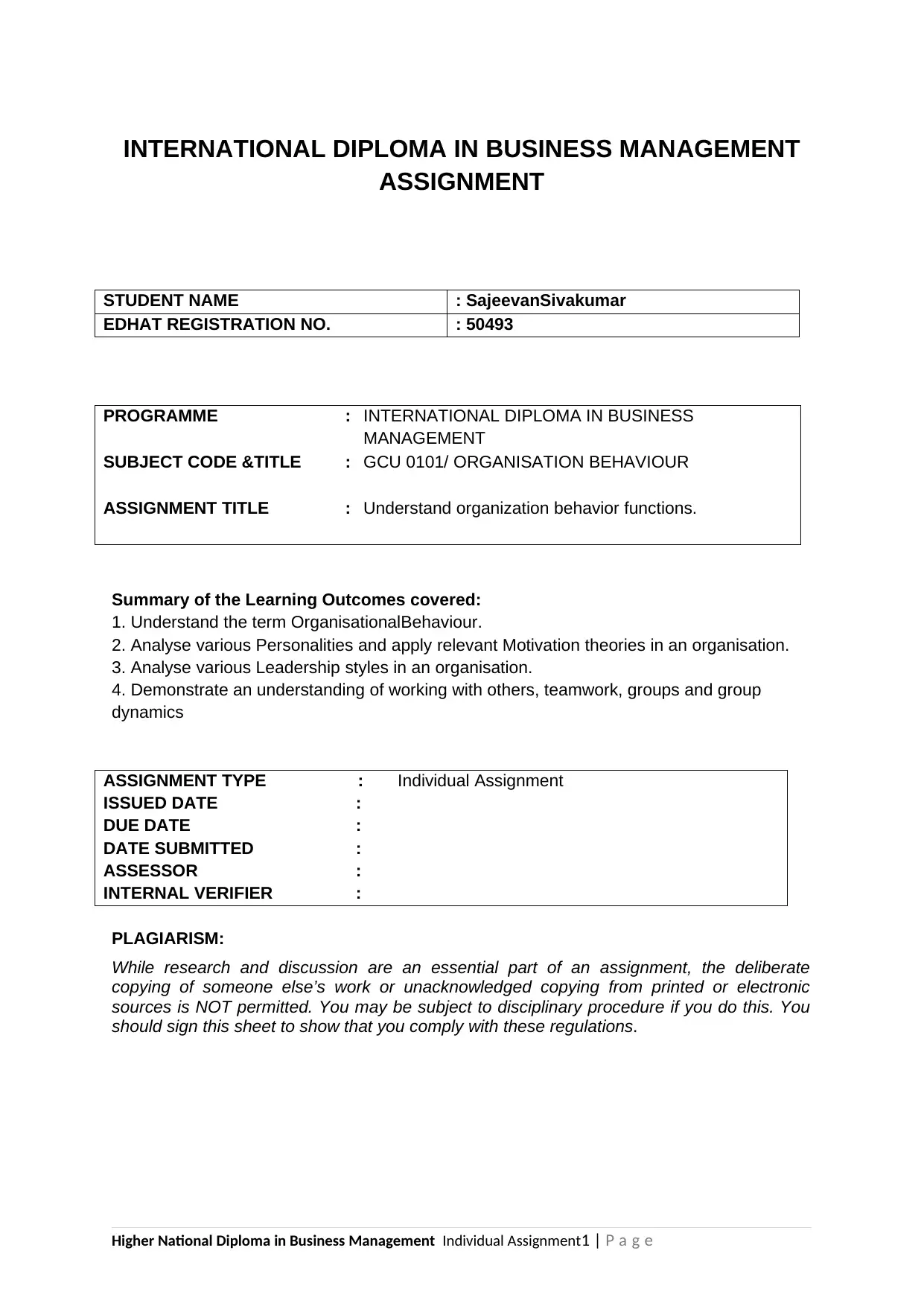
INTERNATIONAL DIPLOMA IN BUSINESS MANAGEMENT
ASSIGNMENT
STUDENT NAME : SajeevanSivakumar
EDHAT REGISTRATION NO. : 50493
PROGRAMME : INTERNATIONAL DIPLOMA IN BUSINESS
MANAGEMENT
SUBJECT CODE &TITLE : GCU 0101/ ORGANISATION BEHAVIOUR
ASSIGNMENT TITLE : Understand organization behavior functions.
Summary of the Learning Outcomes covered:
1. Understand the term OrganisationalBehaviour.
2. Analyse various Personalities and apply relevant Motivation theories in an organisation.
3. Analyse various Leadership styles in an organisation.
4. Demonstrate an understanding of working with others, teamwork, groups and group
dynamics
ASSIGNMENT TYPE : Individual Assignment
ISSUED DATE :
DUE DATE :
DATE SUBMITTED :
ASSESSOR :
INTERNAL VERIFIER :
PLAGIARISM:
While research and discussion are an essential part of an assignment, the deliberate
copying of someone else’s work or unacknowledged copying from printed or electronic
sources is NOT permitted. You may be subject to disciplinary procedure if you do this. You
should sign this sheet to show that you comply with these regulations.
Higher National Diploma in Business Management Individual Assignment1 | P a g e
ASSIGNMENT
STUDENT NAME : SajeevanSivakumar
EDHAT REGISTRATION NO. : 50493
PROGRAMME : INTERNATIONAL DIPLOMA IN BUSINESS
MANAGEMENT
SUBJECT CODE &TITLE : GCU 0101/ ORGANISATION BEHAVIOUR
ASSIGNMENT TITLE : Understand organization behavior functions.
Summary of the Learning Outcomes covered:
1. Understand the term OrganisationalBehaviour.
2. Analyse various Personalities and apply relevant Motivation theories in an organisation.
3. Analyse various Leadership styles in an organisation.
4. Demonstrate an understanding of working with others, teamwork, groups and group
dynamics
ASSIGNMENT TYPE : Individual Assignment
ISSUED DATE :
DUE DATE :
DATE SUBMITTED :
ASSESSOR :
INTERNAL VERIFIER :
PLAGIARISM:
While research and discussion are an essential part of an assignment, the deliberate
copying of someone else’s work or unacknowledged copying from printed or electronic
sources is NOT permitted. You may be subject to disciplinary procedure if you do this. You
should sign this sheet to show that you comply with these regulations.
Higher National Diploma in Business Management Individual Assignment1 | P a g e
Paraphrase This Document
Need a fresh take? Get an instant paraphrase of this document with our AI Paraphraser
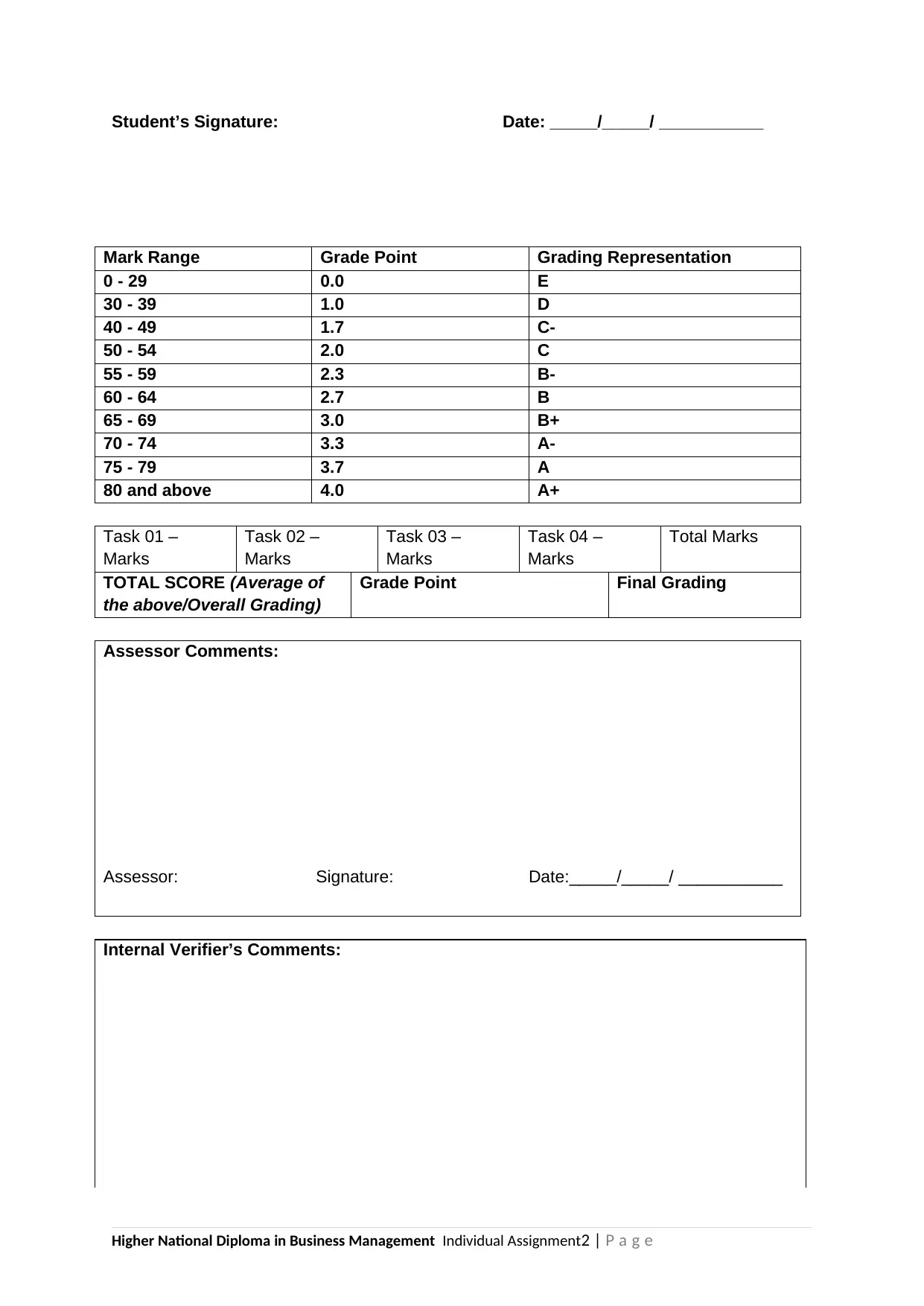
Student’s Signature: Date: _____/_____/ ___________
Mark Range Grade Point Grading Representation
0 - 29 0.0 E
30 - 39 1.0 D
40 - 49 1.7 C-
50 - 54 2.0 C
55 - 59 2.3 B-
60 - 64 2.7 B
65 - 69 3.0 B+
70 - 74 3.3 A-
75 - 79 3.7 A
80 and above 4.0 A+
Task 01 –
Marks
Task 02 –
Marks
Task 03 –
Marks
Task 04 –
Marks
Total Marks
TOTAL SCORE (Average of
the above/Overall Grading)
Grade Point Final Grading
Assessor Comments:
Assessor: Signature: Date:_____/_____/ ___________
Internal Verifier’s Comments:
Higher National Diploma in Business Management Individual Assignment2 | P a g e
Mark Range Grade Point Grading Representation
0 - 29 0.0 E
30 - 39 1.0 D
40 - 49 1.7 C-
50 - 54 2.0 C
55 - 59 2.3 B-
60 - 64 2.7 B
65 - 69 3.0 B+
70 - 74 3.3 A-
75 - 79 3.7 A
80 and above 4.0 A+
Task 01 –
Marks
Task 02 –
Marks
Task 03 –
Marks
Task 04 –
Marks
Total Marks
TOTAL SCORE (Average of
the above/Overall Grading)
Grade Point Final Grading
Assessor Comments:
Assessor: Signature: Date:_____/_____/ ___________
Internal Verifier’s Comments:
Higher National Diploma in Business Management Individual Assignment2 | P a g e
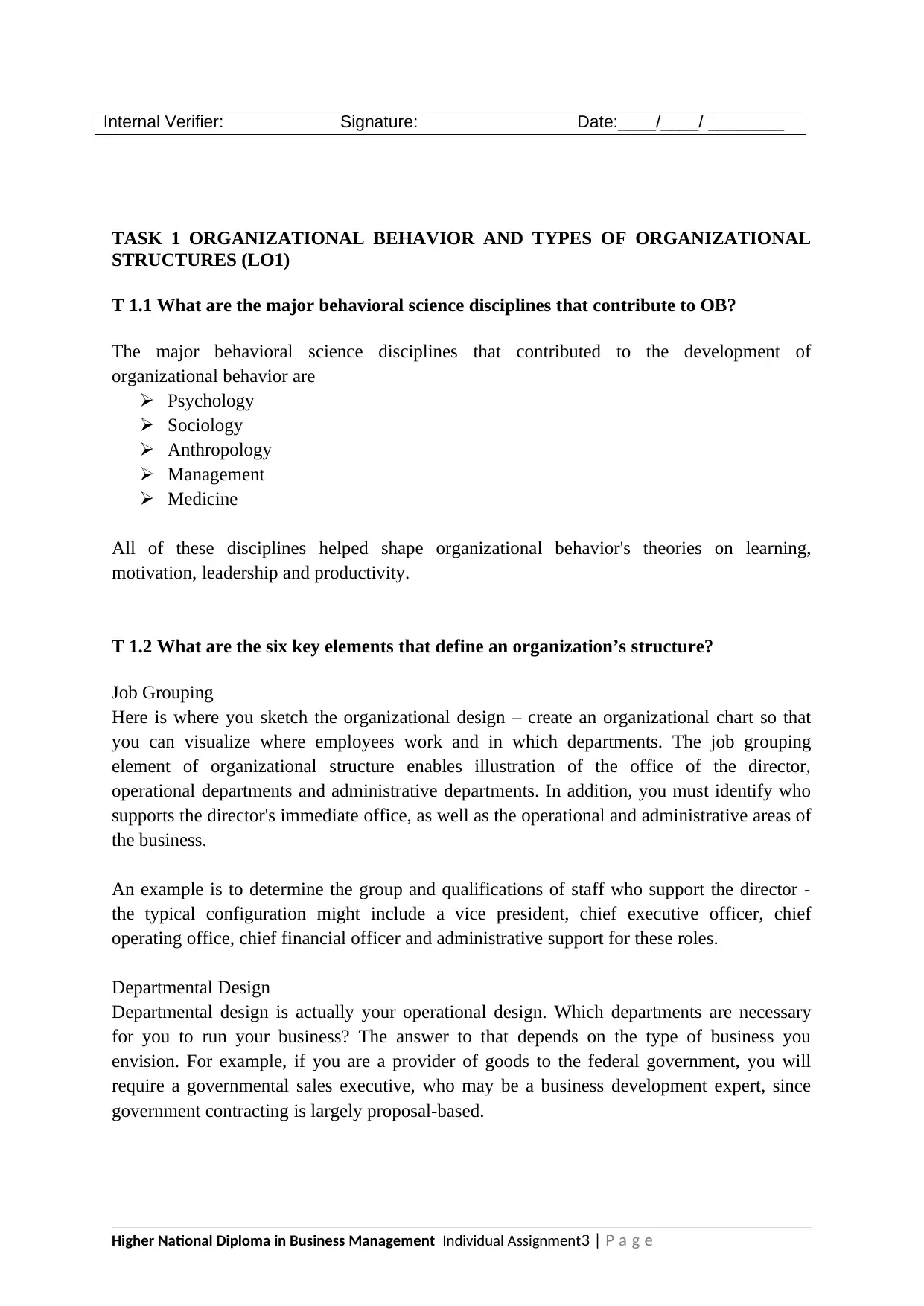
Internal Verifier: Signature: Date:____/____/ ________
TASK 1 ORGANIZATIONAL BEHAVIOR AND TYPES OF ORGANIZATIONAL
STRUCTURES (LO1)
T 1.1 What are the major behavioral science disciplines that contribute to OB?
The major behavioral science disciplines that contributed to the development of
organizational behavior are
Psychology
Sociology
Anthropology
Management
Medicine
All of these disciplines helped shape organizational behavior's theories on learning,
motivation, leadership and productivity.
T 1.2 What are the six key elements that define an organization’s structure?
Job Grouping
Here is where you sketch the organizational design – create an organizational chart so that
you can visualize where employees work and in which departments. The job grouping
element of organizational structure enables illustration of the office of the director,
operational departments and administrative departments. In addition, you must identify who
supports the director's immediate office, as well as the operational and administrative areas of
the business.
An example is to determine the group and qualifications of staff who support the director -
the typical configuration might include a vice president, chief executive officer, chief
operating office, chief financial officer and administrative support for these roles.
Departmental Design
Departmental design is actually your operational design. Which departments are necessary
for you to run your business? The answer to that depends on the type of business you
envision. For example, if you are a provider of goods to the federal government, you will
require a governmental sales executive, who may be a business development expert, since
government contracting is largely proposal-based.
Higher National Diploma in Business Management Individual Assignment3 | P a g e
TASK 1 ORGANIZATIONAL BEHAVIOR AND TYPES OF ORGANIZATIONAL
STRUCTURES (LO1)
T 1.1 What are the major behavioral science disciplines that contribute to OB?
The major behavioral science disciplines that contributed to the development of
organizational behavior are
Psychology
Sociology
Anthropology
Management
Medicine
All of these disciplines helped shape organizational behavior's theories on learning,
motivation, leadership and productivity.
T 1.2 What are the six key elements that define an organization’s structure?
Job Grouping
Here is where you sketch the organizational design – create an organizational chart so that
you can visualize where employees work and in which departments. The job grouping
element of organizational structure enables illustration of the office of the director,
operational departments and administrative departments. In addition, you must identify who
supports the director's immediate office, as well as the operational and administrative areas of
the business.
An example is to determine the group and qualifications of staff who support the director -
the typical configuration might include a vice president, chief executive officer, chief
operating office, chief financial officer and administrative support for these roles.
Departmental Design
Departmental design is actually your operational design. Which departments are necessary
for you to run your business? The answer to that depends on the type of business you
envision. For example, if you are a provider of goods to the federal government, you will
require a governmental sales executive, who may be a business development expert, since
government contracting is largely proposal-based.
Higher National Diploma in Business Management Individual Assignment3 | P a g e
⊘ This is a preview!⊘
Do you want full access?
Subscribe today to unlock all pages.

Trusted by 1+ million students worldwide
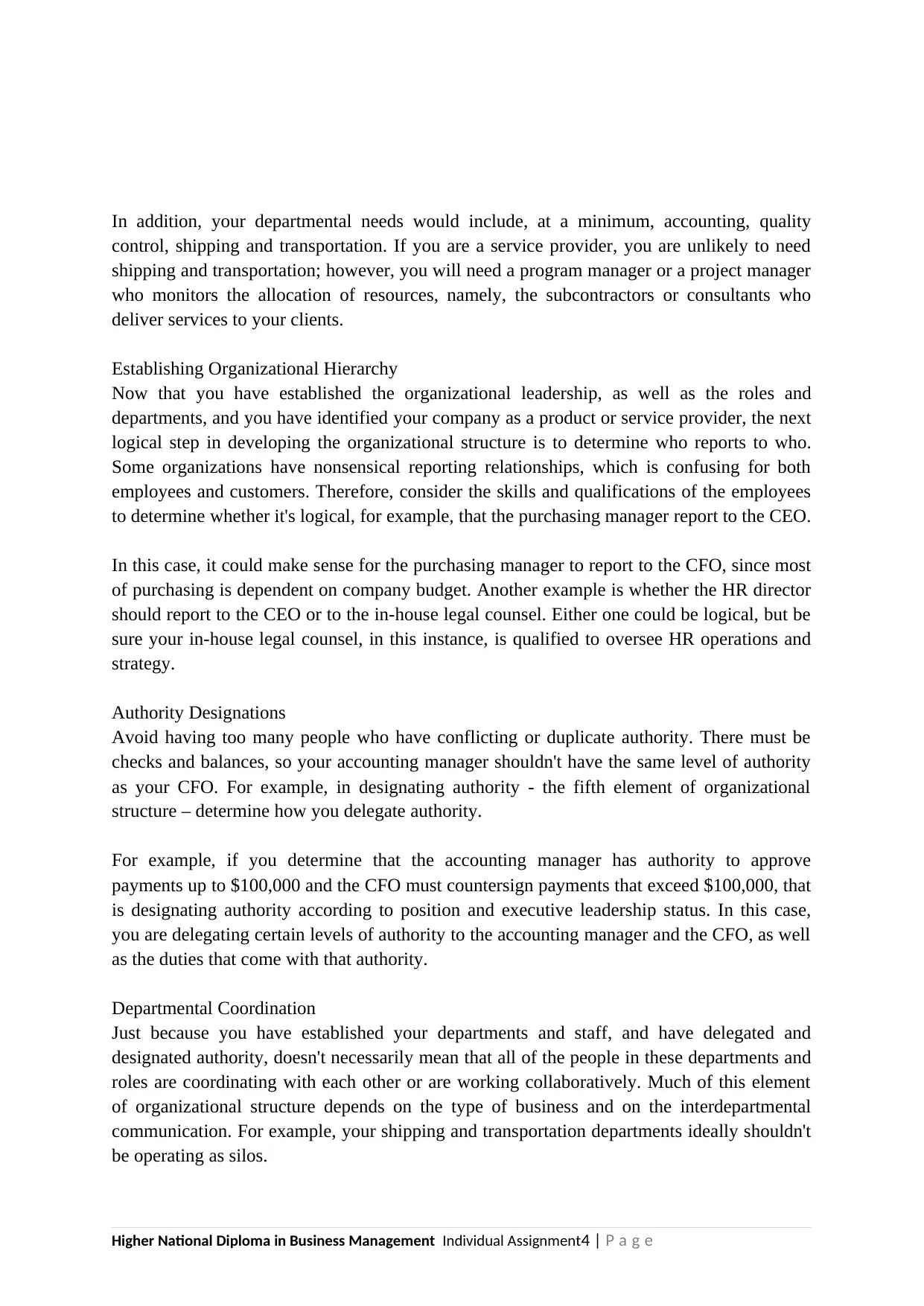
In addition, your departmental needs would include, at a minimum, accounting, quality
control, shipping and transportation. If you are a service provider, you are unlikely to need
shipping and transportation; however, you will need a program manager or a project manager
who monitors the allocation of resources, namely, the subcontractors or consultants who
deliver services to your clients.
Establishing Organizational Hierarchy
Now that you have established the organizational leadership, as well as the roles and
departments, and you have identified your company as a product or service provider, the next
logical step in developing the organizational structure is to determine who reports to who.
Some organizations have nonsensical reporting relationships, which is confusing for both
employees and customers. Therefore, consider the skills and qualifications of the employees
to determine whether it's logical, for example, that the purchasing manager report to the CEO.
In this case, it could make sense for the purchasing manager to report to the CFO, since most
of purchasing is dependent on company budget. Another example is whether the HR director
should report to the CEO or to the in-house legal counsel. Either one could be logical, but be
sure your in-house legal counsel, in this instance, is qualified to oversee HR operations and
strategy.
Authority Designations
Avoid having too many people who have conflicting or duplicate authority. There must be
checks and balances, so your accounting manager shouldn't have the same level of authority
as your CFO. For example, in designating authority - the fifth element of organizational
structure – determine how you delegate authority.
For example, if you determine that the accounting manager has authority to approve
payments up to $100,000 and the CFO must countersign payments that exceed $100,000, that
is designating authority according to position and executive leadership status. In this case,
you are delegating certain levels of authority to the accounting manager and the CFO, as well
as the duties that come with that authority.
Departmental Coordination
Just because you have established your departments and staff, and have delegated and
designated authority, doesn't necessarily mean that all of the people in these departments and
roles are coordinating with each other or are working collaboratively. Much of this element
of organizational structure depends on the type of business and on the interdepartmental
communication. For example, your shipping and transportation departments ideally shouldn't
be operating as silos.
Higher National Diploma in Business Management Individual Assignment4 | P a g e
control, shipping and transportation. If you are a service provider, you are unlikely to need
shipping and transportation; however, you will need a program manager or a project manager
who monitors the allocation of resources, namely, the subcontractors or consultants who
deliver services to your clients.
Establishing Organizational Hierarchy
Now that you have established the organizational leadership, as well as the roles and
departments, and you have identified your company as a product or service provider, the next
logical step in developing the organizational structure is to determine who reports to who.
Some organizations have nonsensical reporting relationships, which is confusing for both
employees and customers. Therefore, consider the skills and qualifications of the employees
to determine whether it's logical, for example, that the purchasing manager report to the CEO.
In this case, it could make sense for the purchasing manager to report to the CFO, since most
of purchasing is dependent on company budget. Another example is whether the HR director
should report to the CEO or to the in-house legal counsel. Either one could be logical, but be
sure your in-house legal counsel, in this instance, is qualified to oversee HR operations and
strategy.
Authority Designations
Avoid having too many people who have conflicting or duplicate authority. There must be
checks and balances, so your accounting manager shouldn't have the same level of authority
as your CFO. For example, in designating authority - the fifth element of organizational
structure – determine how you delegate authority.
For example, if you determine that the accounting manager has authority to approve
payments up to $100,000 and the CFO must countersign payments that exceed $100,000, that
is designating authority according to position and executive leadership status. In this case,
you are delegating certain levels of authority to the accounting manager and the CFO, as well
as the duties that come with that authority.
Departmental Coordination
Just because you have established your departments and staff, and have delegated and
designated authority, doesn't necessarily mean that all of the people in these departments and
roles are coordinating with each other or are working collaboratively. Much of this element
of organizational structure depends on the type of business and on the interdepartmental
communication. For example, your shipping and transportation departments ideally shouldn't
be operating as silos.
Higher National Diploma in Business Management Individual Assignment4 | P a g e
Paraphrase This Document
Need a fresh take? Get an instant paraphrase of this document with our AI Paraphraser
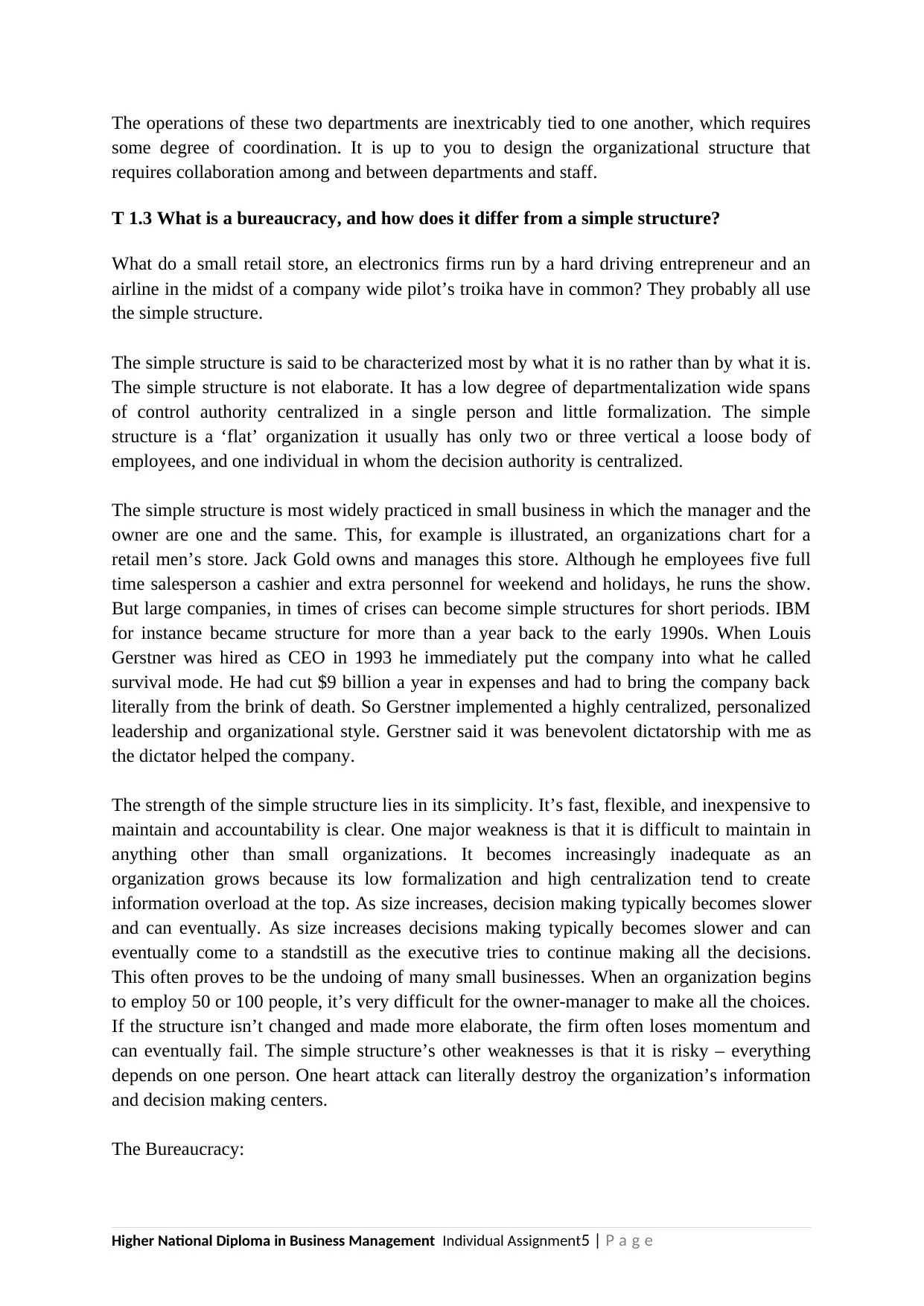
The operations of these two departments are inextricably tied to one another, which requires
some degree of coordination. It is up to you to design the organizational structure that
requires collaboration among and between departments and staff.
T 1.3 What is a bureaucracy, and how does it differ from a simple structure?
What do a small retail store, an electronics firms run by a hard driving entrepreneur and an
airline in the midst of a company wide pilot’s troika have in common? They probably all use
the simple structure.
The simple structure is said to be characterized most by what it is no rather than by what it is.
The simple structure is not elaborate. It has a low degree of departmentalization wide spans
of control authority centralized in a single person and little formalization. The simple
structure is a ‘flat’ organization it usually has only two or three vertical a loose body of
employees, and one individual in whom the decision authority is centralized.
The simple structure is most widely practiced in small business in which the manager and the
owner are one and the same. This, for example is illustrated, an organizations chart for a
retail men’s store. Jack Gold owns and manages this store. Although he employees five full
time salesperson a cashier and extra personnel for weekend and holidays, he runs the show.
But large companies, in times of crises can become simple structures for short periods. IBM
for instance became structure for more than a year back to the early 1990s. When Louis
Gerstner was hired as CEO in 1993 he immediately put the company into what he called
survival mode. He had cut $9 billion a year in expenses and had to bring the company back
literally from the brink of death. So Gerstner implemented a highly centralized, personalized
leadership and organizational style. Gerstner said it was benevolent dictatorship with me as
the dictator helped the company.
The strength of the simple structure lies in its simplicity. It’s fast, flexible, and inexpensive to
maintain and accountability is clear. One major weakness is that it is difficult to maintain in
anything other than small organizations. It becomes increasingly inadequate as an
organization grows because its low formalization and high centralization tend to create
information overload at the top. As size increases, decision making typically becomes slower
and can eventually. As size increases decisions making typically becomes slower and can
eventually come to a standstill as the executive tries to continue making all the decisions.
This often proves to be the undoing of many small businesses. When an organization begins
to employ 50 or 100 people, it’s very difficult for the owner-manager to make all the choices.
If the structure isn’t changed and made more elaborate, the firm often loses momentum and
can eventually fail. The simple structure’s other weaknesses is that it is risky – everything
depends on one person. One heart attack can literally destroy the organization’s information
and decision making centers.
The Bureaucracy:
Higher National Diploma in Business Management Individual Assignment5 | P a g e
some degree of coordination. It is up to you to design the organizational structure that
requires collaboration among and between departments and staff.
T 1.3 What is a bureaucracy, and how does it differ from a simple structure?
What do a small retail store, an electronics firms run by a hard driving entrepreneur and an
airline in the midst of a company wide pilot’s troika have in common? They probably all use
the simple structure.
The simple structure is said to be characterized most by what it is no rather than by what it is.
The simple structure is not elaborate. It has a low degree of departmentalization wide spans
of control authority centralized in a single person and little formalization. The simple
structure is a ‘flat’ organization it usually has only two or three vertical a loose body of
employees, and one individual in whom the decision authority is centralized.
The simple structure is most widely practiced in small business in which the manager and the
owner are one and the same. This, for example is illustrated, an organizations chart for a
retail men’s store. Jack Gold owns and manages this store. Although he employees five full
time salesperson a cashier and extra personnel for weekend and holidays, he runs the show.
But large companies, in times of crises can become simple structures for short periods. IBM
for instance became structure for more than a year back to the early 1990s. When Louis
Gerstner was hired as CEO in 1993 he immediately put the company into what he called
survival mode. He had cut $9 billion a year in expenses and had to bring the company back
literally from the brink of death. So Gerstner implemented a highly centralized, personalized
leadership and organizational style. Gerstner said it was benevolent dictatorship with me as
the dictator helped the company.
The strength of the simple structure lies in its simplicity. It’s fast, flexible, and inexpensive to
maintain and accountability is clear. One major weakness is that it is difficult to maintain in
anything other than small organizations. It becomes increasingly inadequate as an
organization grows because its low formalization and high centralization tend to create
information overload at the top. As size increases, decision making typically becomes slower
and can eventually. As size increases decisions making typically becomes slower and can
eventually come to a standstill as the executive tries to continue making all the decisions.
This often proves to be the undoing of many small businesses. When an organization begins
to employ 50 or 100 people, it’s very difficult for the owner-manager to make all the choices.
If the structure isn’t changed and made more elaborate, the firm often loses momentum and
can eventually fail. The simple structure’s other weaknesses is that it is risky – everything
depends on one person. One heart attack can literally destroy the organization’s information
and decision making centers.
The Bureaucracy:
Higher National Diploma in Business Management Individual Assignment5 | P a g e
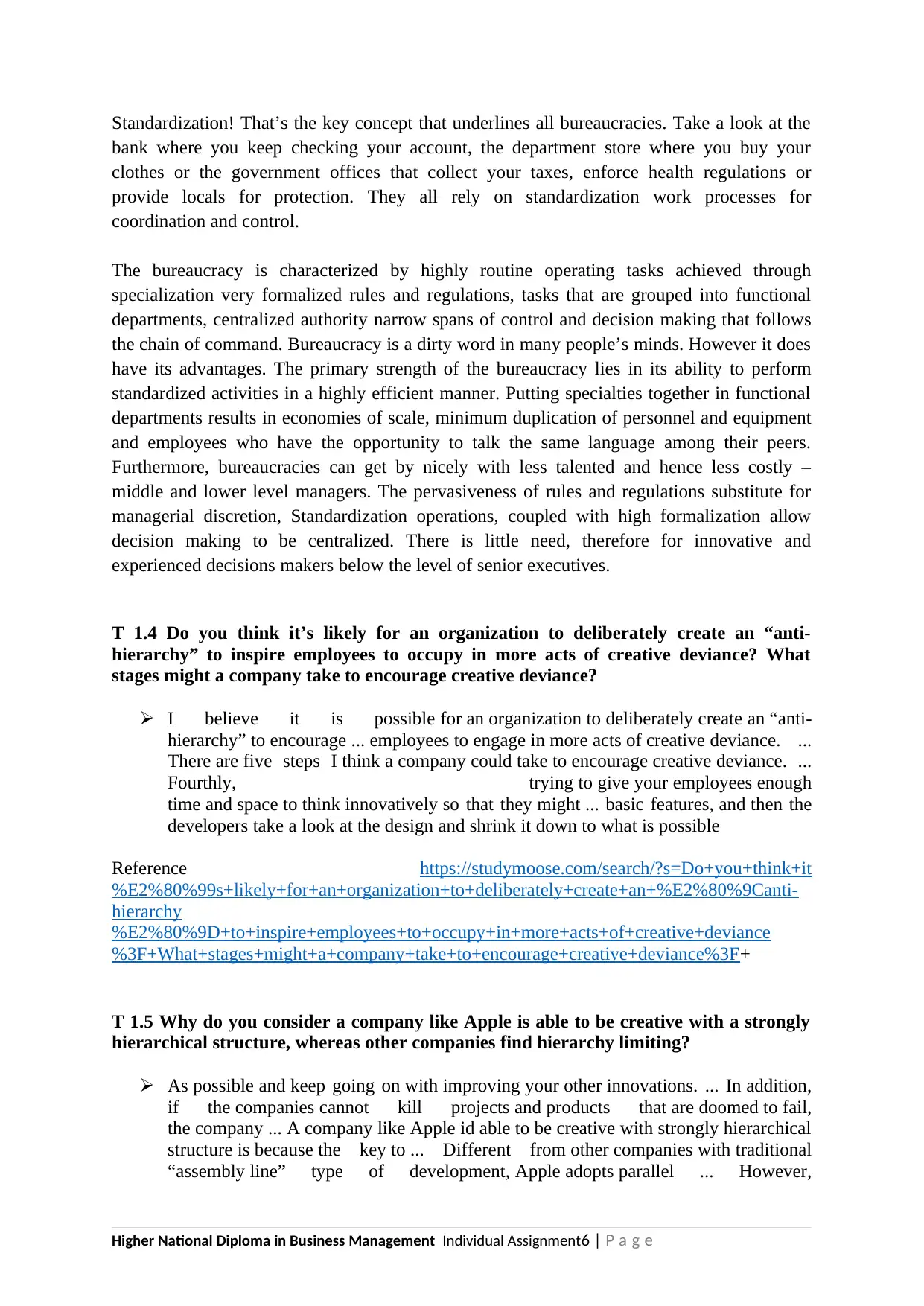
Standardization! That’s the key concept that underlines all bureaucracies. Take a look at the
bank where you keep checking your account, the department store where you buy your
clothes or the government offices that collect your taxes, enforce health regulations or
provide locals for protection. They all rely on standardization work processes for
coordination and control.
The bureaucracy is characterized by highly routine operating tasks achieved through
specialization very formalized rules and regulations, tasks that are grouped into functional
departments, centralized authority narrow spans of control and decision making that follows
the chain of command. Bureaucracy is a dirty word in many people’s minds. However it does
have its advantages. The primary strength of the bureaucracy lies in its ability to perform
standardized activities in a highly efficient manner. Putting specialties together in functional
departments results in economies of scale, minimum duplication of personnel and equipment
and employees who have the opportunity to talk the same language among their peers.
Furthermore, bureaucracies can get by nicely with less talented and hence less costly –
middle and lower level managers. The pervasiveness of rules and regulations substitute for
managerial discretion, Standardization operations, coupled with high formalization allow
decision making to be centralized. There is little need, therefore for innovative and
experienced decisions makers below the level of senior executives.
T 1.4 Do you think it’s likely for an organization to deliberately create an “anti-
hierarchy” to inspire employees to occupy in more acts of creative deviance? What
stages might a company take to encourage creative deviance?
I believe it is possible for an organization to deliberately create an “anti-
hierarchy” to encourage ... employees to engage in more acts of creative deviance. ...
There are five steps I think a company could take to encourage creative deviance. ...
Fourthly, trying to give your employees enough
time and space to think innovatively so that they might ... basic features, and then the
developers take a look at the design and shrink it down to what is possible
Reference https://studymoose.com/search/?s=Do+you+think+it
%E2%80%99s+likely+for+an+organization+to+deliberately+create+an+%E2%80%9Canti-
hierarchy
%E2%80%9D+to+inspire+employees+to+occupy+in+more+acts+of+creative+deviance
%3F+What+stages+might+a+company+take+to+encourage+creative+deviance%3F+
T 1.5 Why do you consider a company like Apple is able to be creative with a strongly
hierarchical structure, whereas other companies find hierarchy limiting?
As possible and keep going on with improving your other innovations. ... In addition,
if the companies cannot kill projects and products that are doomed to fail,
the company ... A company like Apple id able to be creative with strongly hierarchical
structure is because the key to ... Different from other companies with traditional
“assembly line” type of development, Apple adopts parallel ... However,
Higher National Diploma in Business Management Individual Assignment6 | P a g e
bank where you keep checking your account, the department store where you buy your
clothes or the government offices that collect your taxes, enforce health regulations or
provide locals for protection. They all rely on standardization work processes for
coordination and control.
The bureaucracy is characterized by highly routine operating tasks achieved through
specialization very formalized rules and regulations, tasks that are grouped into functional
departments, centralized authority narrow spans of control and decision making that follows
the chain of command. Bureaucracy is a dirty word in many people’s minds. However it does
have its advantages. The primary strength of the bureaucracy lies in its ability to perform
standardized activities in a highly efficient manner. Putting specialties together in functional
departments results in economies of scale, minimum duplication of personnel and equipment
and employees who have the opportunity to talk the same language among their peers.
Furthermore, bureaucracies can get by nicely with less talented and hence less costly –
middle and lower level managers. The pervasiveness of rules and regulations substitute for
managerial discretion, Standardization operations, coupled with high formalization allow
decision making to be centralized. There is little need, therefore for innovative and
experienced decisions makers below the level of senior executives.
T 1.4 Do you think it’s likely for an organization to deliberately create an “anti-
hierarchy” to inspire employees to occupy in more acts of creative deviance? What
stages might a company take to encourage creative deviance?
I believe it is possible for an organization to deliberately create an “anti-
hierarchy” to encourage ... employees to engage in more acts of creative deviance. ...
There are five steps I think a company could take to encourage creative deviance. ...
Fourthly, trying to give your employees enough
time and space to think innovatively so that they might ... basic features, and then the
developers take a look at the design and shrink it down to what is possible
Reference https://studymoose.com/search/?s=Do+you+think+it
%E2%80%99s+likely+for+an+organization+to+deliberately+create+an+%E2%80%9Canti-
hierarchy
%E2%80%9D+to+inspire+employees+to+occupy+in+more+acts+of+creative+deviance
%3F+What+stages+might+a+company+take+to+encourage+creative+deviance%3F+
T 1.5 Why do you consider a company like Apple is able to be creative with a strongly
hierarchical structure, whereas other companies find hierarchy limiting?
As possible and keep going on with improving your other innovations. ... In addition,
if the companies cannot kill projects and products that are doomed to fail,
the company ... A company like Apple id able to be creative with strongly hierarchical
structure is because the key to ... Different from other companies with traditional
“assembly line” type of development, Apple adopts parallel ... However,
Higher National Diploma in Business Management Individual Assignment6 | P a g e
⊘ This is a preview!⊘
Do you want full access?
Subscribe today to unlock all pages.

Trusted by 1+ million students worldwide
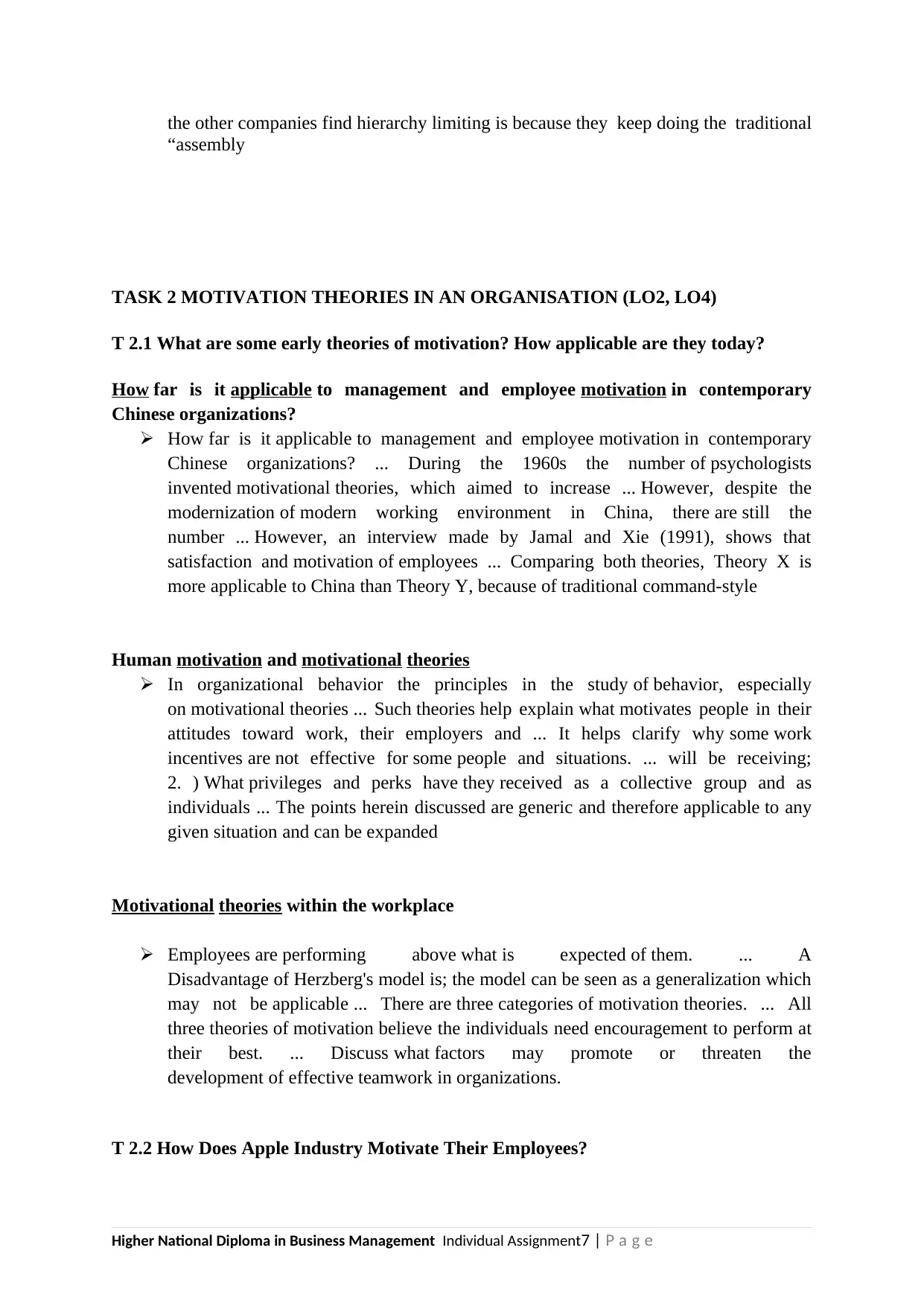
the other companies find hierarchy limiting is because they keep doing the traditional
“assembly
TASK 2 MOTIVATION THEORIES IN AN ORGANISATION (LO2, LO4)
T 2.1 What are some early theories of motivation? How applicable are they today?
How far is it applicable to management and employee motivation in contemporary
Chinese organizations?
How far is it applicable to management and employee motivation in contemporary
Chinese organizations? ... During the 1960s the number of psychologists
invented motivational theories, which aimed to increase ... However, despite the
modernization of modern working environment in China, there are still the
number ... However, an interview made by Jamal and Xie (1991), shows that
satisfaction and motivation of employees ... Comparing both theories, Theory X is
more applicable to China than Theory Y, because of traditional command-style
Human motivation and motivational theories
In organizational behavior the principles in the study of behavior, especially
on motivational theories ... Such theories help explain what motivates people in their
attitudes toward work, their employers and ... It helps clarify why some work
incentives are not effective for some people and situations. ... will be receiving;
2. ) What privileges and perks have they received as a collective group and as
individuals ... The points herein discussed are generic and therefore applicable to any
given situation and can be expanded
Motivational theories within the workplace
Employees are performing above what is expected of them. ... A
Disadvantage of Herzberg's model is; the model can be seen as a generalization which
may not be applicable ... There are three categories of motivation theories. ... All
three theories of motivation believe the individuals need encouragement to perform at
their best. ... Discuss what factors may promote or threaten the
development of effective teamwork in organizations.
T 2.2 How Does Apple Industry Motivate Their Employees?
Higher National Diploma in Business Management Individual Assignment7 | P a g e
“assembly
TASK 2 MOTIVATION THEORIES IN AN ORGANISATION (LO2, LO4)
T 2.1 What are some early theories of motivation? How applicable are they today?
How far is it applicable to management and employee motivation in contemporary
Chinese organizations?
How far is it applicable to management and employee motivation in contemporary
Chinese organizations? ... During the 1960s the number of psychologists
invented motivational theories, which aimed to increase ... However, despite the
modernization of modern working environment in China, there are still the
number ... However, an interview made by Jamal and Xie (1991), shows that
satisfaction and motivation of employees ... Comparing both theories, Theory X is
more applicable to China than Theory Y, because of traditional command-style
Human motivation and motivational theories
In organizational behavior the principles in the study of behavior, especially
on motivational theories ... Such theories help explain what motivates people in their
attitudes toward work, their employers and ... It helps clarify why some work
incentives are not effective for some people and situations. ... will be receiving;
2. ) What privileges and perks have they received as a collective group and as
individuals ... The points herein discussed are generic and therefore applicable to any
given situation and can be expanded
Motivational theories within the workplace
Employees are performing above what is expected of them. ... A
Disadvantage of Herzberg's model is; the model can be seen as a generalization which
may not be applicable ... There are three categories of motivation theories. ... All
three theories of motivation believe the individuals need encouragement to perform at
their best. ... Discuss what factors may promote or threaten the
development of effective teamwork in organizations.
T 2.2 How Does Apple Industry Motivate Their Employees?
Higher National Diploma in Business Management Individual Assignment7 | P a g e
Paraphrase This Document
Need a fresh take? Get an instant paraphrase of this document with our AI Paraphraser
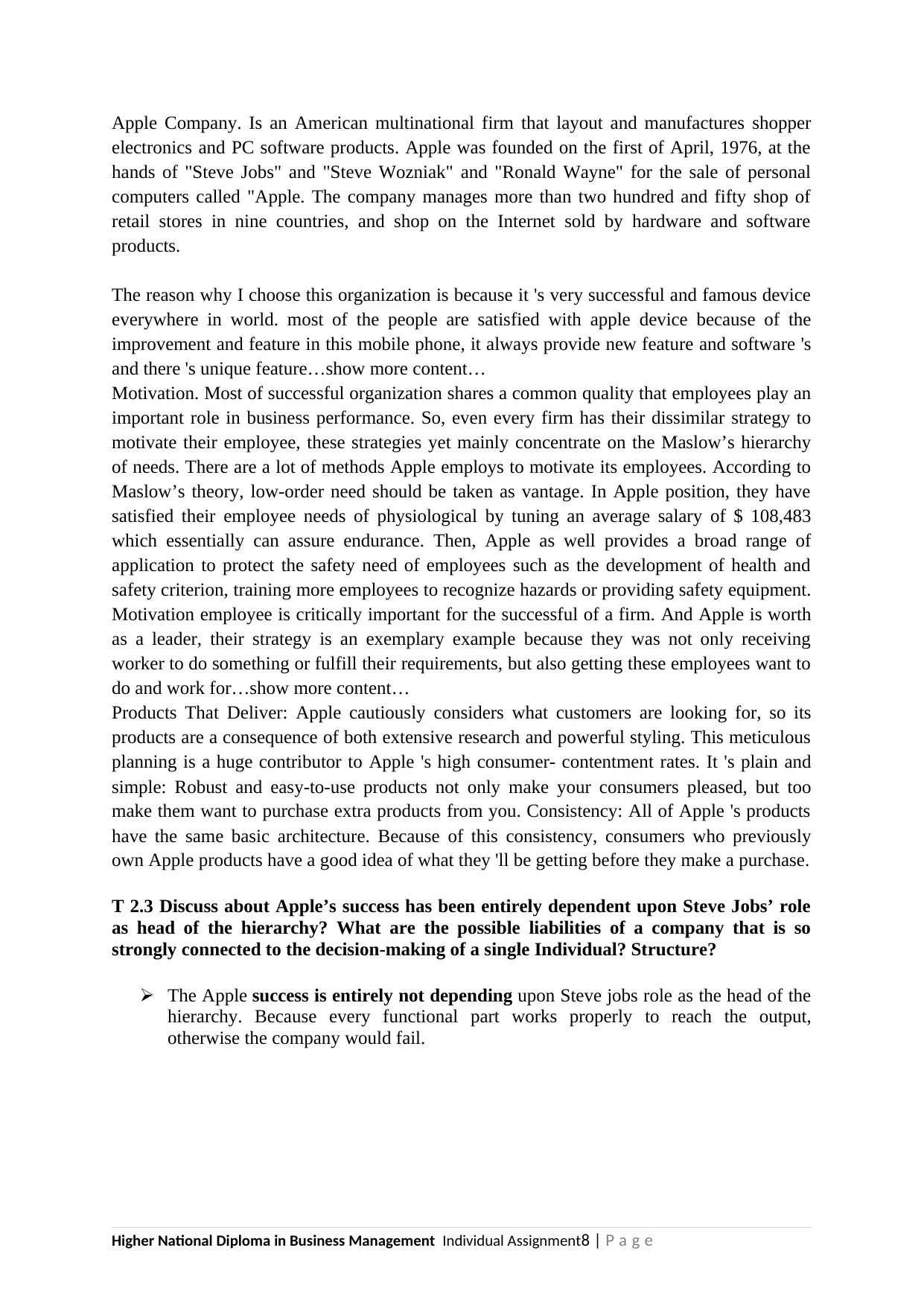
Apple Company. Is an American multinational firm that layout and manufactures shopper
electronics and PC software products. Apple was founded on the first of April, 1976, at the
hands of "Steve Jobs" and "Steve Wozniak" and "Ronald Wayne" for the sale of personal
computers called "Apple. The company manages more than two hundred and fifty shop of
retail stores in nine countries, and shop on the Internet sold by hardware and software
products.
The reason why I choose this organization is because it 's very successful and famous device
everywhere in world. most of the people are satisfied with apple device because of the
improvement and feature in this mobile phone, it always provide new feature and software 's
and there 's unique feature…show more content…
Motivation. Most of successful organization shares a common quality that employees play an
important role in business performance. So, even every firm has their dissimilar strategy to
motivate their employee, these strategies yet mainly concentrate on the Maslow’s hierarchy
of needs. There are a lot of methods Apple employs to motivate its employees. According to
Maslow’s theory, low-order need should be taken as vantage. In Apple position, they have
satisfied their employee needs of physiological by tuning an average salary of $ 108,483
which essentially can assure endurance. Then, Apple as well provides a broad range of
application to protect the safety need of employees such as the development of health and
safety criterion, training more employees to recognize hazards or providing safety equipment.
Motivation employee is critically important for the successful of a firm. And Apple is worth
as a leader, their strategy is an exemplary example because they was not only receiving
worker to do something or fulfill their requirements, but also getting these employees want to
do and work for…show more content…
Products That Deliver: Apple cautiously considers what customers are looking for, so its
products are a consequence of both extensive research and powerful styling. This meticulous
planning is a huge contributor to Apple 's high consumer- contentment rates. It 's plain and
simple: Robust and easy-to-use products not only make your consumers pleased, but too
make them want to purchase extra products from you. Consistency: All of Apple 's products
have the same basic architecture. Because of this consistency, consumers who previously
own Apple products have a good idea of what they 'll be getting before they make a purchase.
T 2.3 Discuss about Apple’s success has been entirely dependent upon Steve Jobs’ role
as head of the hierarchy? What are the possible liabilities of a company that is so
strongly connected to the decision-making of a single Individual? Structure?
The Apple success is entirely not depending upon Steve jobs role as the head of the
hierarchy. Because every functional part works properly to reach the output,
otherwise the company would fail.
Higher National Diploma in Business Management Individual Assignment8 | P a g e
electronics and PC software products. Apple was founded on the first of April, 1976, at the
hands of "Steve Jobs" and "Steve Wozniak" and "Ronald Wayne" for the sale of personal
computers called "Apple. The company manages more than two hundred and fifty shop of
retail stores in nine countries, and shop on the Internet sold by hardware and software
products.
The reason why I choose this organization is because it 's very successful and famous device
everywhere in world. most of the people are satisfied with apple device because of the
improvement and feature in this mobile phone, it always provide new feature and software 's
and there 's unique feature…show more content…
Motivation. Most of successful organization shares a common quality that employees play an
important role in business performance. So, even every firm has their dissimilar strategy to
motivate their employee, these strategies yet mainly concentrate on the Maslow’s hierarchy
of needs. There are a lot of methods Apple employs to motivate its employees. According to
Maslow’s theory, low-order need should be taken as vantage. In Apple position, they have
satisfied their employee needs of physiological by tuning an average salary of $ 108,483
which essentially can assure endurance. Then, Apple as well provides a broad range of
application to protect the safety need of employees such as the development of health and
safety criterion, training more employees to recognize hazards or providing safety equipment.
Motivation employee is critically important for the successful of a firm. And Apple is worth
as a leader, their strategy is an exemplary example because they was not only receiving
worker to do something or fulfill their requirements, but also getting these employees want to
do and work for…show more content…
Products That Deliver: Apple cautiously considers what customers are looking for, so its
products are a consequence of both extensive research and powerful styling. This meticulous
planning is a huge contributor to Apple 's high consumer- contentment rates. It 's plain and
simple: Robust and easy-to-use products not only make your consumers pleased, but too
make them want to purchase extra products from you. Consistency: All of Apple 's products
have the same basic architecture. Because of this consistency, consumers who previously
own Apple products have a good idea of what they 'll be getting before they make a purchase.
T 2.3 Discuss about Apple’s success has been entirely dependent upon Steve Jobs’ role
as head of the hierarchy? What are the possible liabilities of a company that is so
strongly connected to the decision-making of a single Individual? Structure?
The Apple success is entirely not depending upon Steve jobs role as the head of the
hierarchy. Because every functional part works properly to reach the output,
otherwise the company would fail.
Higher National Diploma in Business Management Individual Assignment8 | P a g e
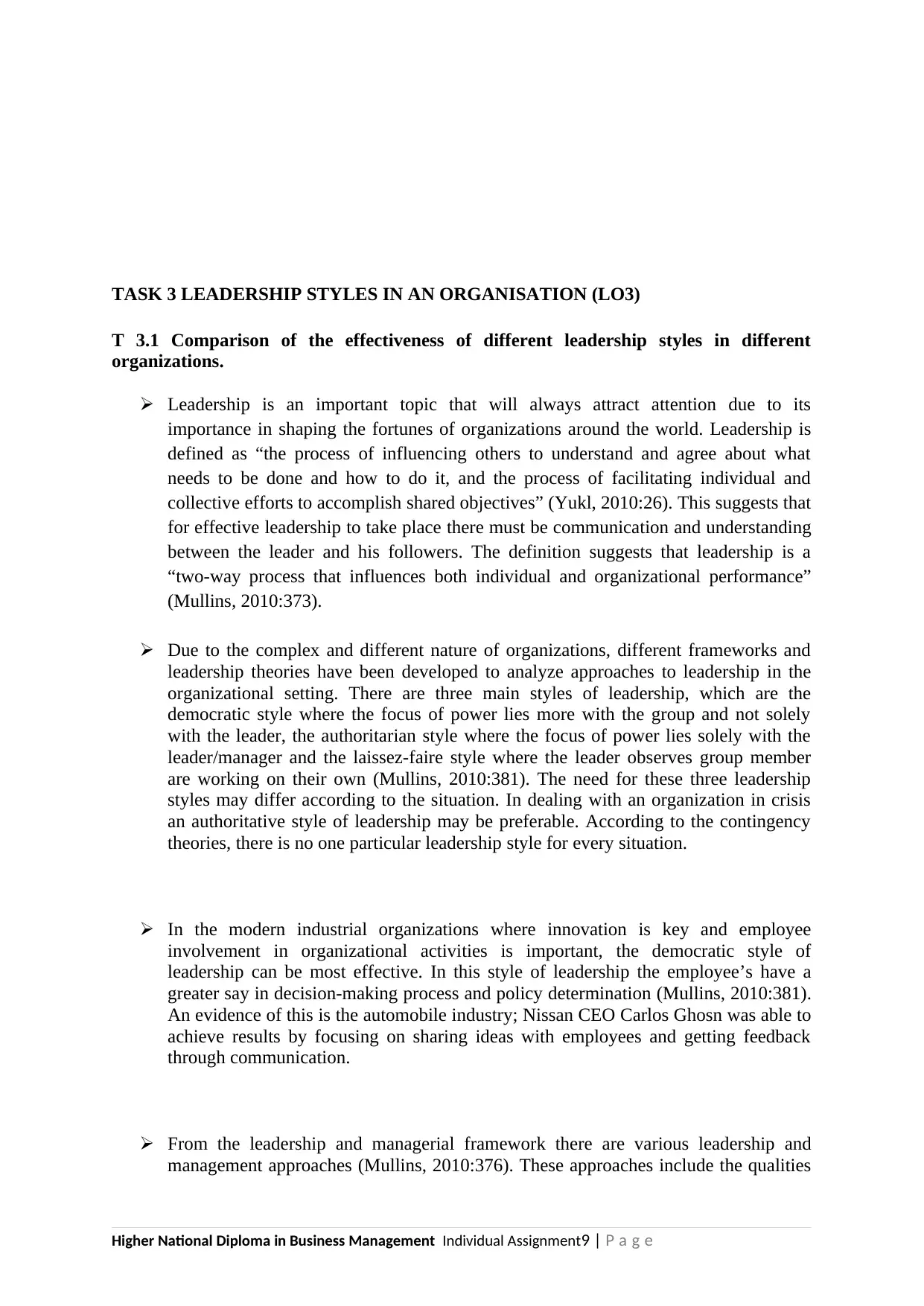
TASK 3 LEADERSHIP STYLES IN AN ORGANISATION (LO3)
T 3.1 Comparison of the effectiveness of different leadership styles in different
organizations.
Leadership is an important topic that will always attract attention due to its
importance in shaping the fortunes of organizations around the world. Leadership is
defined as “the process of influencing others to understand and agree about what
needs to be done and how to do it, and the process of facilitating individual and
collective efforts to accomplish shared objectives” (Yukl, 2010:26). This suggests that
for effective leadership to take place there must be communication and understanding
between the leader and his followers. The definition suggests that leadership is a
“two-way process that influences both individual and organizational performance”
(Mullins, 2010:373).
Due to the complex and different nature of organizations, different frameworks and
leadership theories have been developed to analyze approaches to leadership in the
organizational setting. There are three main styles of leadership, which are the
democratic style where the focus of power lies more with the group and not solely
with the leader, the authoritarian style where the focus of power lies solely with the
leader/manager and the laissez-faire style where the leader observes group member
are working on their own (Mullins, 2010:381). The need for these three leadership
styles may differ according to the situation. In dealing with an organization in crisis
an authoritative style of leadership may be preferable. According to the contingency
theories, there is no one particular leadership style for every situation.
In the modern industrial organizations where innovation is key and employee
involvement in organizational activities is important, the democratic style of
leadership can be most effective. In this style of leadership the employee’s have a
greater say in decision-making process and policy determination (Mullins, 2010:381).
An evidence of this is the automobile industry; Nissan CEO Carlos Ghosn was able to
achieve results by focusing on sharing ideas with employees and getting feedback
through communication.
From the leadership and managerial framework there are various leadership and
management approaches (Mullins, 2010:376). These approaches include the qualities
Higher National Diploma in Business Management Individual Assignment9 | P a g e
T 3.1 Comparison of the effectiveness of different leadership styles in different
organizations.
Leadership is an important topic that will always attract attention due to its
importance in shaping the fortunes of organizations around the world. Leadership is
defined as “the process of influencing others to understand and agree about what
needs to be done and how to do it, and the process of facilitating individual and
collective efforts to accomplish shared objectives” (Yukl, 2010:26). This suggests that
for effective leadership to take place there must be communication and understanding
between the leader and his followers. The definition suggests that leadership is a
“two-way process that influences both individual and organizational performance”
(Mullins, 2010:373).
Due to the complex and different nature of organizations, different frameworks and
leadership theories have been developed to analyze approaches to leadership in the
organizational setting. There are three main styles of leadership, which are the
democratic style where the focus of power lies more with the group and not solely
with the leader, the authoritarian style where the focus of power lies solely with the
leader/manager and the laissez-faire style where the leader observes group member
are working on their own (Mullins, 2010:381). The need for these three leadership
styles may differ according to the situation. In dealing with an organization in crisis
an authoritative style of leadership may be preferable. According to the contingency
theories, there is no one particular leadership style for every situation.
In the modern industrial organizations where innovation is key and employee
involvement in organizational activities is important, the democratic style of
leadership can be most effective. In this style of leadership the employee’s have a
greater say in decision-making process and policy determination (Mullins, 2010:381).
An evidence of this is the automobile industry; Nissan CEO Carlos Ghosn was able to
achieve results by focusing on sharing ideas with employees and getting feedback
through communication.
From the leadership and managerial framework there are various leadership and
management approaches (Mullins, 2010:376). These approaches include the qualities
Higher National Diploma in Business Management Individual Assignment9 | P a g e
⊘ This is a preview!⊘
Do you want full access?
Subscribe today to unlock all pages.

Trusted by 1+ million students worldwide
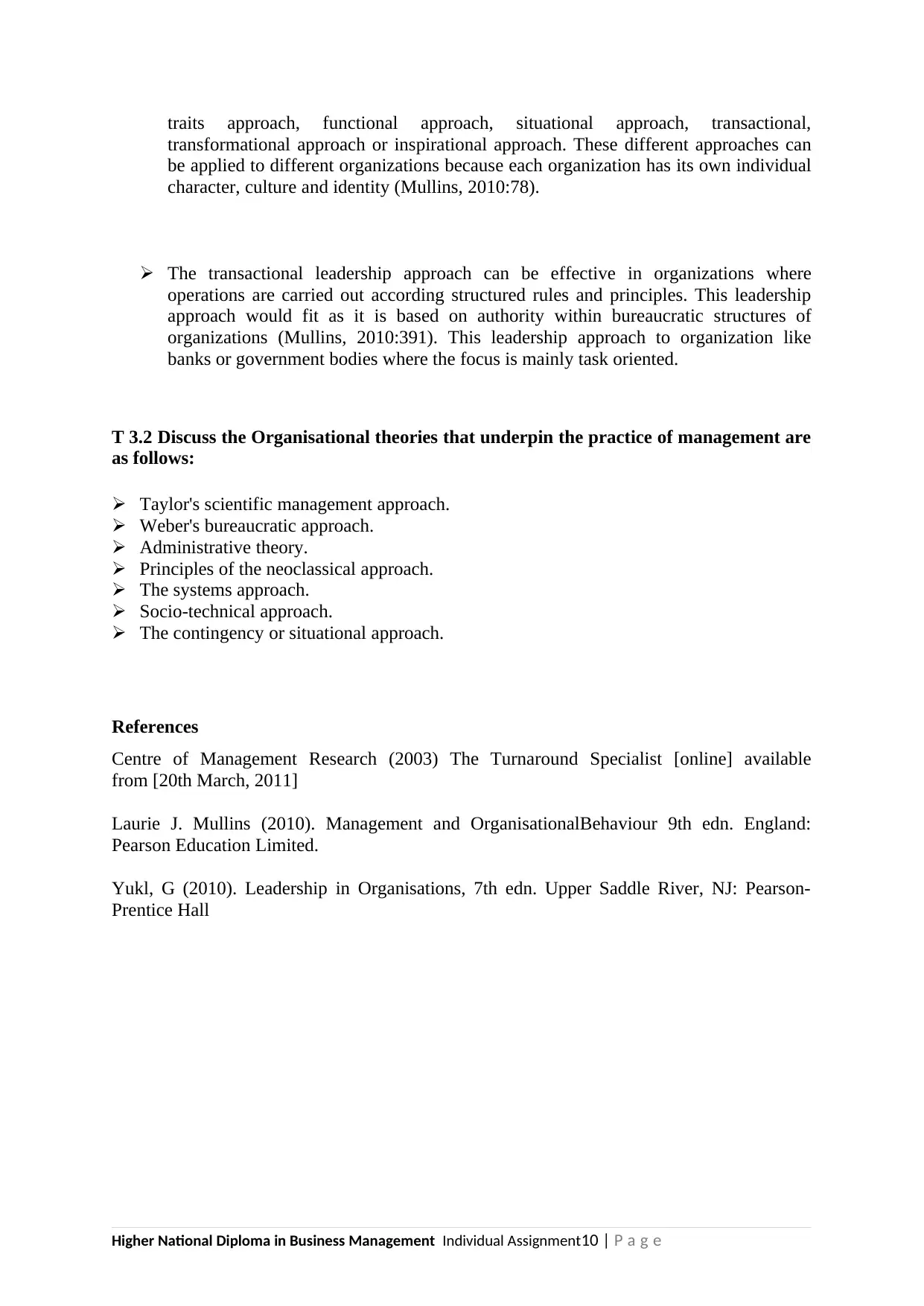
traits approach, functional approach, situational approach, transactional,
transformational approach or inspirational approach. These different approaches can
be applied to different organizations because each organization has its own individual
character, culture and identity (Mullins, 2010:78).
The transactional leadership approach can be effective in organizations where
operations are carried out according structured rules and principles. This leadership
approach would fit as it is based on authority within bureaucratic structures of
organizations (Mullins, 2010:391). This leadership approach to organization like
banks or government bodies where the focus is mainly task oriented.
T 3.2 Discuss the Organisational theories that underpin the practice of management are
as follows:
Taylor's scientific management approach.
Weber's bureaucratic approach.
Administrative theory.
Principles of the neoclassical approach.
The systems approach.
Socio-technical approach.
The contingency or situational approach.
References
Centre of Management Research (2003) The Turnaround Specialist [online] available
from [20th March, 2011]
Laurie J. Mullins (2010). Management and OrganisationalBehaviour 9th edn. England:
Pearson Education Limited.
Yukl, G (2010). Leadership in Organisations, 7th edn. Upper Saddle River, NJ: Pearson-
Prentice Hall
Higher National Diploma in Business Management Individual Assignment10 | P a g e
transformational approach or inspirational approach. These different approaches can
be applied to different organizations because each organization has its own individual
character, culture and identity (Mullins, 2010:78).
The transactional leadership approach can be effective in organizations where
operations are carried out according structured rules and principles. This leadership
approach would fit as it is based on authority within bureaucratic structures of
organizations (Mullins, 2010:391). This leadership approach to organization like
banks or government bodies where the focus is mainly task oriented.
T 3.2 Discuss the Organisational theories that underpin the practice of management are
as follows:
Taylor's scientific management approach.
Weber's bureaucratic approach.
Administrative theory.
Principles of the neoclassical approach.
The systems approach.
Socio-technical approach.
The contingency or situational approach.
References
Centre of Management Research (2003) The Turnaround Specialist [online] available
from [20th March, 2011]
Laurie J. Mullins (2010). Management and OrganisationalBehaviour 9th edn. England:
Pearson Education Limited.
Yukl, G (2010). Leadership in Organisations, 7th edn. Upper Saddle River, NJ: Pearson-
Prentice Hall
Higher National Diploma in Business Management Individual Assignment10 | P a g e
Paraphrase This Document
Need a fresh take? Get an instant paraphrase of this document with our AI Paraphraser
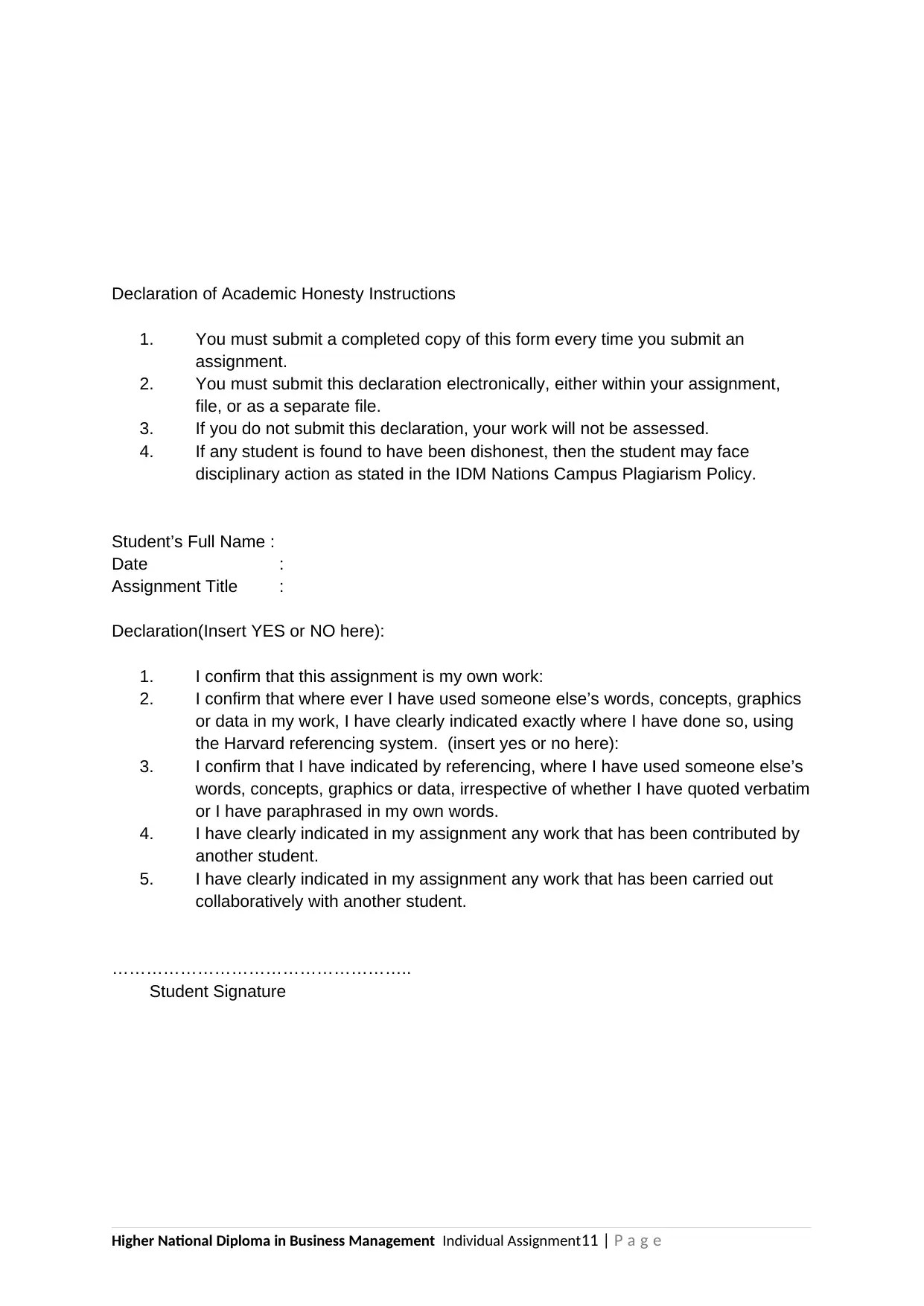
Declaration of Academic Honesty Instructions
1. You must submit a completed copy of this form every time you submit an
assignment.
2. You must submit this declaration electronically, either within your assignment,
file, or as a separate file.
3. If you do not submit this declaration, your work will not be assessed.
4. If any student is found to have been dishonest, then the student may face
disciplinary action as stated in the IDM Nations Campus Plagiarism Policy.
Student’s Full Name :
Date :
Assignment Title :
Declaration(Insert YES or NO here):
1. I confirm that this assignment is my own work:
2. I confirm that where ever I have used someone else’s words, concepts, graphics
or data in my work, I have clearly indicated exactly where I have done so, using
the Harvard referencing system. (insert yes or no here):
3. I confirm that I have indicated by referencing, where I have used someone else’s
words, concepts, graphics or data, irrespective of whether I have quoted verbatim
or I have paraphrased in my own words.
4. I have clearly indicated in my assignment any work that has been contributed by
another student.
5. I have clearly indicated in my assignment any work that has been carried out
collaboratively with another student.
……………………………………………..
Student Signature
Higher National Diploma in Business Management Individual Assignment11 | P a g e
1. You must submit a completed copy of this form every time you submit an
assignment.
2. You must submit this declaration electronically, either within your assignment,
file, or as a separate file.
3. If you do not submit this declaration, your work will not be assessed.
4. If any student is found to have been dishonest, then the student may face
disciplinary action as stated in the IDM Nations Campus Plagiarism Policy.
Student’s Full Name :
Date :
Assignment Title :
Declaration(Insert YES or NO here):
1. I confirm that this assignment is my own work:
2. I confirm that where ever I have used someone else’s words, concepts, graphics
or data in my work, I have clearly indicated exactly where I have done so, using
the Harvard referencing system. (insert yes or no here):
3. I confirm that I have indicated by referencing, where I have used someone else’s
words, concepts, graphics or data, irrespective of whether I have quoted verbatim
or I have paraphrased in my own words.
4. I have clearly indicated in my assignment any work that has been contributed by
another student.
5. I have clearly indicated in my assignment any work that has been carried out
collaboratively with another student.
……………………………………………..
Student Signature
Higher National Diploma in Business Management Individual Assignment11 | P a g e
1 out of 11
Related Documents
Your All-in-One AI-Powered Toolkit for Academic Success.
+13062052269
info@desklib.com
Available 24*7 on WhatsApp / Email
![[object Object]](/_next/static/media/star-bottom.7253800d.svg)
Unlock your academic potential
Copyright © 2020–2025 A2Z Services. All Rights Reserved. Developed and managed by ZUCOL.





